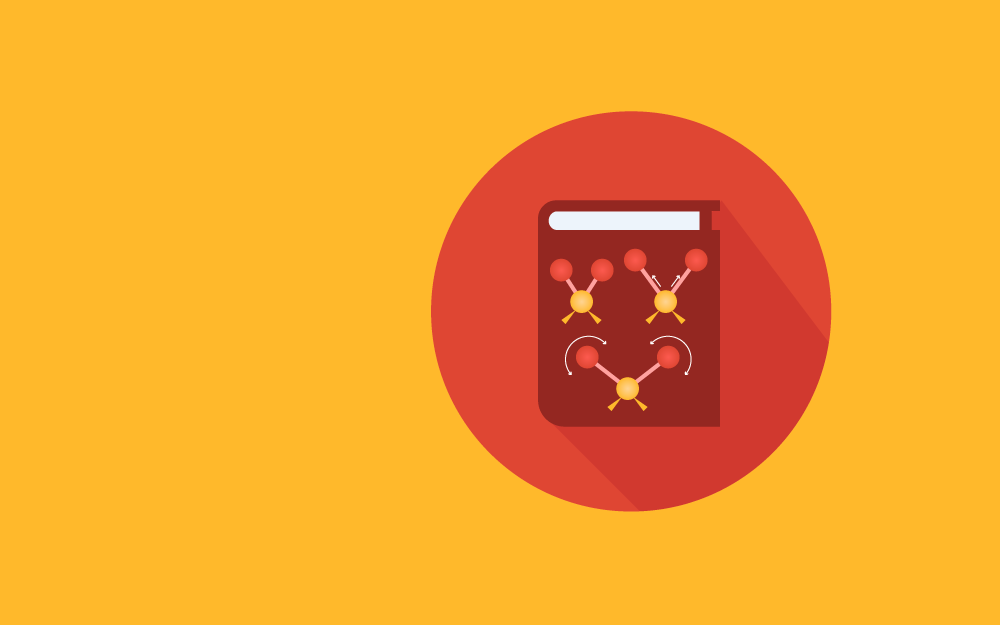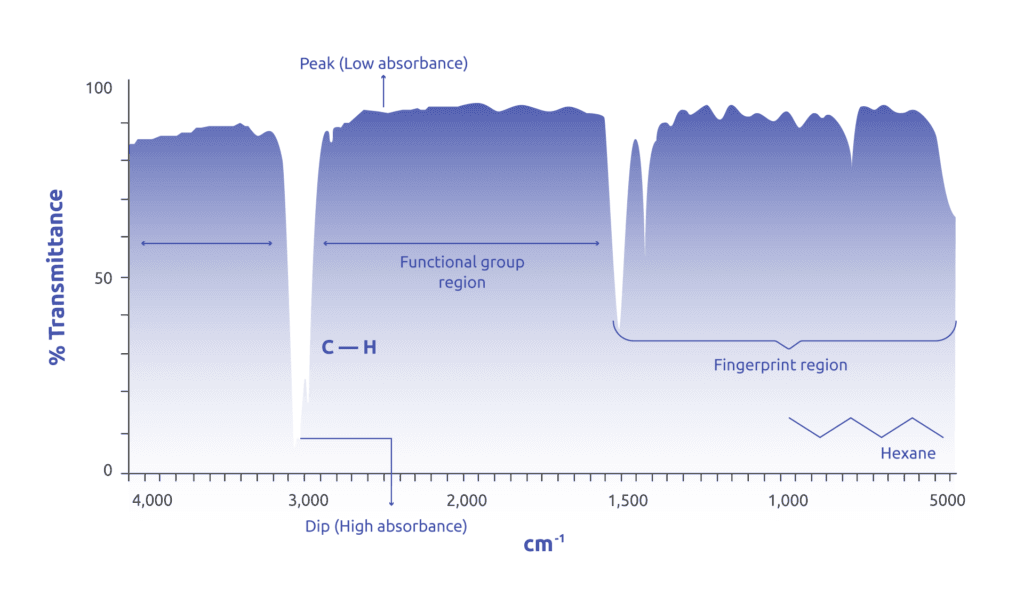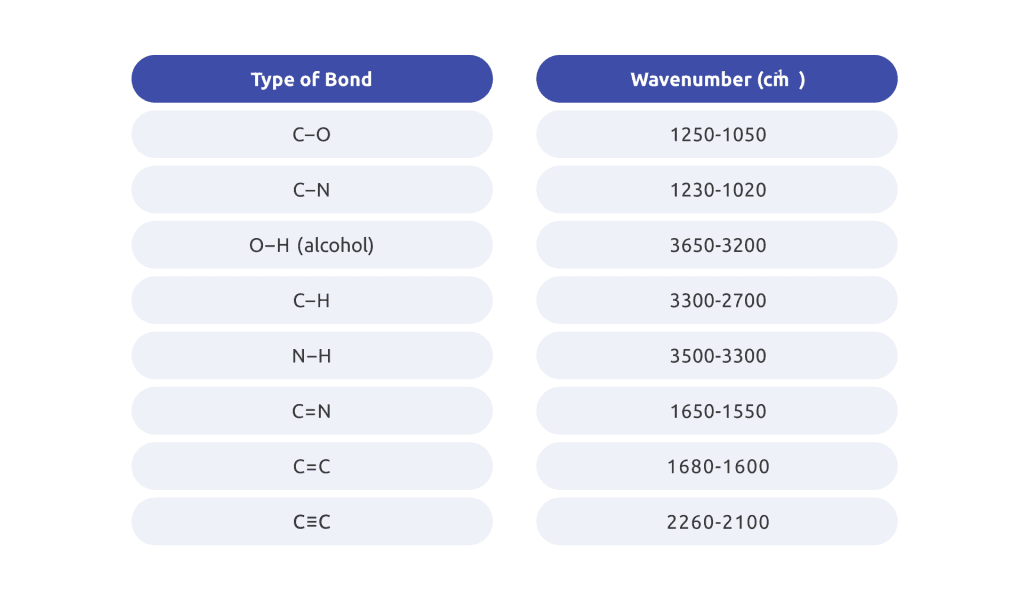

Spectroscopy refers to the interaction between electromagnetic (EM) radiation and matter as a function of its frequency or wavelength.
From this, a number of quantitative and qualitative measurements defining aspects like sample concentrations, structure, chemical compositions etc, can be obtained depending on the spectroscopic technique and spectrum of EM radiation used.
When EM radiation interacts with matter, its frequency can undergo absorption, diffraction, inelastic scattering, emission and impedance by the atoms of the material substance.
In addition, the interaction increases the internal energy transitions of the atoms and depending on the type of EM radiation, it causes the atoms to rotate in the case of microwave radiation, vibrate for infrared, have electron excitation in case of visible light or undergo ionization with UV and x-ray.
Infrared spectrophotometry, also referred to as Infrared spectroscopy (IR spectroscopy) is one of the most useful techniques for structural and functional group analyses and it has been used widely since its inception to identify unknown substances.
This technique utilizes the ability of atoms to absorb infrared frequencies that match their internal vibrational frequency leading to the generation of an absorption spectra specific to the chemical bonds within the sample under analysis.
The technique has found wide applicability in various fields that require identification of organic substances. In research science, IR spectroscopy has been used in chemistry labs to identify and elucidate the structure of chemical substances.
In industry, it has been used in food and drug administration to investigate the presence of (restricted) substances and for quality control to analyze the purity of food and drugs.
The technique has been used in the manufacturing industry to evaluate ongoing reactions by measuring the appearance or disappearance of particular reactants or detecting the formation of polymers.
Infrared spectrophotometry has also been used in the art world to verify authenticity of prized art by testing paint pigments while in forensic science, it has been used to identify substances of interest from crime scenes.
At temperatures above 0o Kelvin, chemical bonds between atoms are not static, they undergo various types of vibrations, referred to as vibrational modes, which alter the length and angle of bonds.
The type and number of vibrations can range from single stretching vibrational mode seen in diatomic molecules to more complex vibrations found in non-linear polyatomic molecules.
The total number of possible vibrational modes in a molecule can be calculated for both linear and nonlinear molecules using the formula 3n-5 and 3n-6 respectively, where n is the number of atoms in the molecule.
For example, a diatomic molecule like N2 has only one possible vibrational mode while H20, a nonlinear polyatomic molecule, has 3 types of vibrations. Not all molecular bonds are active in infrared spectrum, meaning, not all vibrational modes can be observed.
In infrared spectrophotometry, diatomic molecules that are symmetrical (homonuclear molecules) like N2, Cl2, and certain bonds in polyatomic molecules, like CO2, do not absorb infrared frequency and therefore have no IR spectrum.
This means that one might observe less number of absorption spectrum bands compared to the predicted (by calculation) vibrational mode in a molecule. This is because for a molecular bond to be ‘’Infrared active’’, the vibrational mode must involve change in the dipole moment.
When atoms in a molecule absorb EM radiation, they do so in discrete quantities of energy or quanta. Different frequencies of the EM radiation have different levels of energy. The frequencies within the IR spectrum have just enough energy to cause molecules to vibrate.
The lowest vibrational state of a molecule is the ground vibrational state while vibrational states higher than this are called the excited vibrational states.
Molecules will only absorb energy of the frequency that is equivalent to the energy gap required to move them from one vibrational state to the next.
The energy difference between the various vibrational states depends on the bond strength and mass of the elements in the bond. This is why the IR absorption spectra is specific for a particular functional group.
Therefore, what we observe in infrared spectrophotometry is the energy changes required to excite a molecule from the ground vibrational state to subsequent excited vibrational states.
The type of vibrations or vibrational modes refers to the changes in the position of the atoms making up the bond. Vibrational modes are divided into two main categories namely, stretching and bending, as follows;
This involves changes in the bond length between the atoms. The atoms can either move closer to each other, thereby shortening the bond, or further apart.
Stretching can be subdivided into;
This type of vibration refers to the changes in the ‘angle’ between two bonds and can further be subdivided into;
The most common classification of the IR spectrum divides it into three IR regions named in relation to their distance from the visible light spectrum as follows;
The infrared spectrometer (or spectrophotometer) measures the relative amount of energy as a function of the wavelength/frequency of the infrared radiation when it passes through a sample.
The two types of the infrared spectrometer are dispersive infrared spectrometer (DS) and Fourier transform infrared spectrometer (FTIS).
This was the first generation IR spectrometers. The key components are the IF radiation source, entrance slit, monochromator and detector. The source of energy is directed along both a sample and a reference path (for instruments with double beam) and then into the monochromator.
The monochromator splits the IR spectrum into various frequencies and then the slit allows only one frequency at a time to be detected.
The now spatially separated wavelengths of light are directed, by moving the grating through a narrow slit, which chooses which frequencies are being detected, and then onto the detector.
The main difference between FTIS and the DS is that the sample is irradiated with all infrared frequencies simultaneously.
To achieve this, a device called an interferometer is used to split the IR light into two beams, one is reflected by a fixed mirror and the second by a sliding mirror, perpendicular to the fixed one.
This means that the path length of the fixed mirror is constant, while the path of sliding mirror keeps changing, creating an optical path difference between the two beams of light.
The two beams recombine again at the beam splitter and are directed to the sample, due to the optical path difference, the resulting graphs form an interferogram which has to be converted to the normal IR absorption spectra using a mathematical technique known as Fourier transformation.
This is essential for quality data production. Water, glass, plastic, and other infrared absorbing substances are not used to hold or dissolve samples. Instead, salts and salt plates such as sodium chloride, potassium bromide, silver chloride, diamond dust are used to hold/support the sample material. The type of sample to be tested informs the method of preparation.
Solid samples can be crushed into a powder and made into a paste using mineral oil, dissolved in a non-reactive solvent or pressed into a very thin plate using a hydraulic press.
The powder sample is mixed with a specific kind of mineral oil and the paste is smeared evenly on the salt plates for reading. For solids that can be made into solutions, ensure that the solvent does not react with the sample.
After samples dissolves, transfer a drop onto the salt plates for measurement. The thin and transparent pressed sample is made by mixing the ground solid with ground potassium bromide that is approximately 100 times its weight.
Both sample and potassium bromide need to be finely ground because large particles can scatter the IR beam.
Liquid samples are put between two highly polished salt plates such as sodium chloride plates, so as to evenly flatten the sample droplet, then, mounted onto the sample holder for reading.
Gaseous samples are put in salt cells of about 5-10 cms length.
The infrared absorption spectra is usually presented as the percentage transmittance on the y-axis against the wavenumber (and rarely as wavelengths in nm) on the x-axis which is at a range beginning at about 14000-10 cm-1 with most organic substances having an absorption spectra ranging between 4000-400 cm-1.
The graph shows ‘’peaks’’ and ‘’dips’’ where absorption of radiant energy is represented by a dip in the curve with zero transmittance corresponding to 100% absorption of light at a particular IR frequency.
A peak represents low absorbance where 100% transmittance of light represents zero absorbance at a particular frequency. Sometimes, the graph can be presented in terms of % absorbance on the y-axis in which case the peaks and dips are inverted.

Figure 1: An absorption spectrum showing absorption at 3000-2900 cm-1 which is a characteristic of a tetrahedral C-H functional group. The absorption bands at the fingerprint region are used to further pin-point the compounds

Table 1: The stretching frequencies of different bonds. Such reference tables are used to interpret the absorption bands data.
Since the vibrational frequencies of a given functional group correspond to the absorption of a certain frequency, the absorption spectra of a sample are compared with the spectrum of various stored data to identify functional groups in the sample.
Infrared spectroscopy is a powerful method for investigating the structure, functional groups, and compositional changes in organic and inorganic molecules in varied forms. In combinations with other instruments like mass spectrophotometer, NMRI, or microscopes, it forms a part of a powerful analytical tool.
In behavioral neuroscience, the Open Field Test (OFT) remains one of the most widely used assays to evaluate rodent models of affect, cognition, and motivation. It provides a non-invasive framework for examining how animals respond to novelty, stress, and pharmacological or environmental manipulations. Among the test’s core metrics, the percentage of time spent in the center zone offers a uniquely normalized and sensitive measure of an animal’s emotional reactivity and willingness to engage with a potentially risky environment.
This metric is calculated as the proportion of time spent in the central area of the arena—typically the inner 25%—relative to the entire session duration. By normalizing this value, researchers gain a behaviorally informative variable that is resilient to fluctuations in session length or overall movement levels. This makes it especially valuable in comparative analyses, longitudinal monitoring, and cross-model validation.
Unlike raw center duration, which can be affected by trial design inconsistencies, the percentage-based measure enables clearer comparisons across animals, treatments, and conditions. It plays a key role in identifying trait anxiety, avoidance behavior, risk-taking tendencies, and environmental adaptation, making it indispensable in both basic and translational research contexts.
Whereas simple center duration provides absolute time, the percentage-based metric introduces greater interpretability and reproducibility, especially when comparing different animal models, treatment conditions, or experimental setups. It is particularly effective for quantifying avoidance behaviors, risk assessment strategies, and trait anxiety profiles in both acute and longitudinal designs.
This metric reflects the relative amount of time an animal chooses to spend in the open, exposed portion of the arena—typically defined as the inner 25% of a square or circular enclosure. Because rodents innately prefer the periphery (thigmotaxis), time in the center is inversely associated with anxiety-like behavior. As such, this percentage is considered a sensitive, normalized index of:
Critically, because this metric is normalized by session duration, it accommodates variability in activity levels or testing conditions. This makes it especially suitable for comparing across individuals, treatment groups, or timepoints in longitudinal studies.
A high percentage of center time indicates reduced anxiety, increased novelty-seeking, or pharmacological modulation (e.g., anxiolysis). Conversely, a low percentage suggests emotional inhibition, behavioral avoidance, or contextual hypervigilance. reduced anxiety, increased novelty-seeking, or pharmacological modulation (e.g., anxiolysis). Conversely, a low percentage suggests emotional inhibition, behavioral avoidance, or contextual hypervigilance.
The percentage of center time is one of the most direct, unconditioned readouts of anxiety-like behavior in rodents. It is frequently reduced in models of PTSD, chronic stress, or early-life adversity, where animals exhibit persistent avoidance of the center due to heightened emotional reactivity. This metric can also distinguish between acute anxiety responses and enduring trait anxiety, especially in longitudinal or developmental studies. Its normalized nature makes it ideal for comparing across cohorts with variable locomotor profiles, helping researchers detect true affective changes rather than activity-based confounds.
Rodents that spend more time in the center zone typically exhibit broader and more flexible exploration strategies. This behavior reflects not only reduced anxiety but also cognitive engagement and environmental curiosity. High center percentage is associated with robust spatial learning, attentional scanning, and memory encoding functions, supported by coordinated activation in the prefrontal cortex, hippocampus, and basal forebrain. In contrast, reduced center engagement may signal spatial rigidity, attentional narrowing, or cognitive withdrawal, particularly in models of neurodegeneration or aging.
The open field test remains one of the most widely accepted platforms for testing anxiolytic and psychotropic drugs. The percentage of center time reliably increases following administration of anxiolytic agents such as benzodiazepines, SSRIs, and GABA-A receptor agonists. This metric serves as a sensitive and reproducible endpoint in preclinical dose-finding studies, mechanistic pharmacology, and compound screening pipelines. It also aids in differentiating true anxiolytic effects from sedation or motor suppression by integrating with other behavioral parameters like distance traveled and entry count (Prut & Belzung, 2003).
Sex-based differences in emotional regulation often manifest in open field behavior, with female rodents generally exhibiting higher variability in center zone metrics due to hormonal cycling. For example, estrogen has been shown to facilitate exploratory behavior and increase center occupancy, while progesterone and stress-induced corticosterone often reduce it. Studies involving gonadectomy, hormone replacement, or sex-specific genetic knockouts use this metric to quantify the impact of endocrine factors on anxiety and exploratory behavior. As such, it remains a vital tool for dissecting sex-dependent neurobehavioral dynamics.
The percentage of center time is one of the most direct, unconditioned readouts of anxiety-like behavior in rodents. It is frequently reduced in models of PTSD, chronic stress, or early-life adversity. Because it is normalized, this metric is especially helpful for distinguishing between genuine avoidance and low general activity.
Environmental Control: Uniformity in environmental conditions is essential. Lighting should be evenly diffused to avoid shadow bias, and noise should be minimized to prevent stress-induced variability. The arena must be cleaned between trials using odor-neutral solutions to eliminate scent trails or pheromone cues that may affect zone preference. Any variation in these conditions can introduce systematic bias in center zone behavior. Use consistent definitions of the center zone (commonly 25% of total area) to allow valid comparisons. Software-based segmentation enhances spatial precision.
Evaluating how center time evolves across the duration of a session—divided into early, middle, and late thirds—provides insight into behavioral transitions and adaptive responses. Animals may begin by avoiding the center, only to gradually increase center time as they habituate to the environment. Conversely, persistently low center time across the session can signal prolonged anxiety, fear generalization, or a trait-like avoidance phenotype.
To validate the significance of center time percentage, it should be examined alongside results from other anxiety-related tests such as the Elevated Plus Maze, Light-Dark Box, or Novelty Suppressed Feeding. Concordance across paradigms supports the reliability of center time as a trait marker, while discordance may indicate task-specific reactivity or behavioral dissociation.
When paired with high-resolution scoring of behavioral events such as rearing, grooming, defecation, or immobility, center time offers a richer view of the animal’s internal state. For example, an animal that spends substantial time in the center while grooming may be coping with mild stress, while another that remains immobile in the periphery may be experiencing more severe anxiety. Microstructure analysis aids in decoding the complexity behind spatial behavior.
Animals naturally vary in their exploratory style. By analyzing percentage of center time across subjects, researchers can identify behavioral subgroups—such as consistently bold individuals who frequently explore the center versus cautious animals that remain along the periphery. These classifications can be used to examine predictors of drug response, resilience to stress, or vulnerability to neuropsychiatric disorders.
In studies with large cohorts or multiple behavioral variables, machine learning techniques such as hierarchical clustering or principal component analysis can incorporate center time percentage to discover novel phenotypic groupings. These data-driven approaches help uncover latent dimensions of behavior that may not be visible through univariate analyses alone.
Total locomotion helps contextualize center time. Low percentage values in animals with minimal movement may reflect sedation or fatigue, while similar values in high-mobility subjects suggest deliberate avoidance. This metric helps distinguish emotional versus motor causes of low center engagement.
This measure indicates how often the animal initiates exploration of the center zone. When combined with percentage of time, it differentiates between frequent but brief visits (indicative of anxiety or impulsivity) versus fewer but sustained center engagements (suggesting comfort and behavioral confidence).
The delay before the first center entry reflects initial threat appraisal. Longer latencies may be associated with heightened fear or low motivation, while shorter latencies are typically linked to exploratory drive or low anxiety.
Time spent hugging the walls offers a spatial counterbalance to center metrics. High thigmotaxis and low center time jointly support an interpretation of strong avoidance behavior. This inverse relationship helps triangulate affective and motivational states.
By expressing center zone activity as a proportion of total trial time, researchers gain a metric that is resistant to session variability and more readily comparable across time, treatment, and model conditions. This normalized measure enhances reproducibility and statistical power, particularly in multi-cohort or cross-laboratory designs.
For experimental designs aimed at assessing anxiety, exploratory strategy, or affective state, the percentage of time spent in the center offers one of the most robust and interpretable measures available in the Open Field Test.
Written by researchers, for researchers — powered by Conduct Science.








Monday – Friday
9 AM – 5 PM EST
DISCLAIMER: ConductScience and affiliate products are NOT designed for human consumption, testing, or clinical utilization. They are designed for pre-clinical utilization only. Customers purchasing apparatus for the purposes of scientific research or veterinary care affirm adherence to applicable regulatory bodies for the country in which their research or care is conducted.